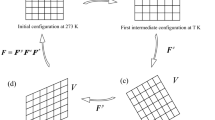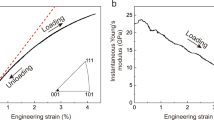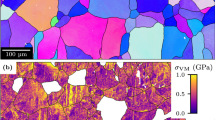Abstract
HEYN pointed out in 1914 that plastic deformation of a metal could result in irregular internal stresses because of the inherent elastic and plastic anisotropy of the grains1. With the development of X-ray diffraction methods it has been possible to study the internal stresses by direct experiment. Such X-ray measurements, made by Wood and his co-workers, led, however, to the unexpected result that the internal stresses in a number of metals were by no means irregular, being related in magnitude and direction to the previously applied stress2. Iron and carbon steels are typical examples. It was concluded that the stresses were too regular to be explained satisfactorily by the type envisaged by Heyn (which we shall term intergranular stresses).
This is a preview of subscription content, access via your institution
Access options
Subscribe to this journal
Receive 51 print issues and online access
$199.00 per year
only $3.90 per issue
Buy this article
- Purchase on Springer Link
- Instant access to full article PDF
Prices may be subject to local taxes which are calculated during checkout
Similar content being viewed by others
References
Heyn, E., J. Inst. Met., 12, 3 (1914).
Wood, W. A., and Smith, S. L., Proc. Roy. Soc., A, 182, 404 (1944). Wood, W. A., ibid, (in the press).
Greenough, G. B., Nature, 160, 258 (1947).
Author information
Authors and Affiliations
Rights and permissions
About this article
Cite this article
WOOD, W., DEWSNAP, N. Internal Stresses in Metals. Nature 161, 682–683 (1948). https://doi.org/10.1038/161682b0
Issue Date:
DOI: https://doi.org/10.1038/161682b0
This article is cited by
-
X-ray stress analysis
Experimental Mechanics (1966)
Comments
By submitting a comment you agree to abide by our Terms and Community Guidelines. If you find something abusive or that does not comply with our terms or guidelines please flag it as inappropriate.



